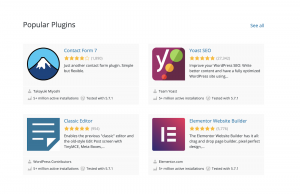There’s a silent killer in your workplace.
It lurks in the shadows, depleting your energy, sacking your concentration, and shaking your confidence. Your co-workers talk about it in hushed tones (if at all), and your boss is in denial of its very existence…
Its name?
Stress.
It’s no joke. Countless studies show that excess stress can cause real physical symptoms like headaches, upset stomach, increased blood pressure, chest pain, and trouble sleeping. That’s not to mention its role in mood disorders like anxiety and depression.
In the infographic below, we’ll take a look a look at the alarming costs of workplace stress, the warning signs that you’re too stressed, and 6 simple methods for reducing that stress – so you can get back to kicking butt.
OSHA (The Occupational Safety and Health Administration) deemed stress a “hazard of the workplace,” and estimates put the cost of stress at $ 190 billion a year in annual healthcare bills.
And it’s not isolated to specific industries – the problem is widespread. 65% of adults say that work is the source of their significant stress.
On top of that, a joint team of Harvard and Stanford researchers looked at data from the General Social Survey and the American Community Survey and found that stressful jobs might actually lower your life expectancy.
Of course, not all stress is created equal. A certain amount of healthy stress in the workplace is actually a good thing.
Experts make a distinction between eustress (good) and distress (bad), and point out that eustress is actually necessary for individuals to make breakthroughs and companies to grow.
What’s the difference? Eustress is motivating. It keeps you on task and helps you cross the finish the line. Distress is debilitating, and occurs when the good stress builds up and becomes to much to cope with.
Negative work stress can come from a variety of factors. (Any of these sound familiar?)
- Fear of being laid off or fired
- Additional overtime due to budget cuts
- Pressure due to constantly rising expectations
- Pressure to constantly work at peak levels
How do you know if your stress level is out of control? Here are a few warning signs:
- Depressed mood – you may lose confidence, become angry, irritable, or withdrawn
- You lose interest in your work, and a sense of apathy takes over
- You’re unable to sleep or experience fatigue during the day
- You have trouble concentrating
- You experience muscle tension, headaches, or stomach problems
- You notice a decrease in your libido
- You turn to alcohol or drugs as a coping mechanism
The key is to manage stress so it remains at a healthy level and doesn’t become overwhelming.
Easier said than done, right?
We’re here to help. Here are 6 tried and true methods for reducing workplace stress – so you can get back to kicking butt.
1. Form Positive Relationships

While the negative effects of stress are very real, much of the stress we experience can be alleviated simply by talking about it.
That’s why positive relationships at work are so important. Even if they can’t solve your problems, the simple act of verbalizing your stress with someone you trust can actually reduce the severity – or clear it up altogether.
Additionally, friendships can take your mind off the stressors and provide a buffer between your daily tasks and your negative thoughts.
It’s one of the reasons why we rolled out the SnackNation buddy program. Every new hire gets a veteran “buddy” to show them the ropes, introduce them to people, and provide guidance and support.
By design, this “buddy” isn’t a manager. It’s someone in whom you can confide any concern, personal or professional. Our SN buddies are trained to lend an ear and provide judgment-free advice.
Here are some tips for fostering positive personal relationships at work:
- Put down your smartphone! Instead of burying your head in your Instagram feed at lunch, leave your phone at your desk during breaks and engage with co-workers.
- Encourage vulnerability. Vulnerability exercises are something we do at our SnackNation offsites. After breaking out into smaller groups of four or five, everyone in the group is encouraged to share something personal – often a meaningful experience from their upbringing. The relationships formed during these vulnerability exercises are the basis for some of the deepest and longest-lasting relationships at the company.
- Start your own “buddy” or mentorship program at your office. Remember, these relationships should be both personal and professional. It works best when buddies are from different departments, so there’s less chance of office politics becoming a factor.
2. Start Exercising (or Exercise More)

With its mood-boosting and endorphin-releasing properties, regular aerobic exercise is a natural stress reducer.
Exercise’s ability to elevate mood is well documented. Numerous studies going back to the early 80’s found that regular exercise can improve mood for people with moderate depression. In fact, a 1999 study found that exercise was just as effective of eliminating depression antidepressants.
Exercise also helps get your mind off your stressful thoughts. By training yourself to be in the moment and focus on your body’s movements (rather than mulling over your worries), exercise can be a form of active meditation and have a calming effect on the body and mind.
You should aim for a minimum of 30 minutes of activity each day.
If you don’t have the time to fit in a run or gym session before or after work each day, here are some tips to increase your mobility in the office:
- Launch a wellness challenge. Gamify company fitness by launching a wellness challenge. Shoot for a team-wide goal, but also reward top performers to foster some friendly competition. At SnackNation, we passed out fitness trackers and added up our steps in a bid to virtually “walk” the distance from LA to San Francisco during our wellness month. Each week, we also named a winner for the most active team member.
- Switch to an “Active Desk.” Sitting for long stretches at your desk is not good for your health. Alternatively, standing desks get you out of your chair and on your feet. This works your stabilizing leg and stomach muscles, your heart, and lets you burn extra calories. We’re big fans of Oristand’s functional and affordable cardboard standing desks.
- Take walking meetings. In a recent interview with the Awesome Office Show, BittyFoods CEO Megan Miller explained that she gets in daily exercise by taking calls while strolling through San Francisco’s Golden Gate Park. LA-based skincare brand Murad also installed a walking track in their office space to encourage team members to get up from their desks during the day.
3. Eat Healthy and Nutritious Foods
Ever heard the phrase “eat your feelings”?
It’s a real phenomenon. Many people turn to unhealthy “comfort foods” as a way to manage stress.
Why does this happen? When we’re stressed, our brain releases the hormone cortisol, which makes us crave salty, sweet, and fat-laden foods for the temporary pleasure they bring.
But ironically, “stress eating” only exacerbates the problem. Sugar or fat-laden foods like pizza, burgers, and ice cream make us feel lethargic, and less likely to tackle the problems that lay before us, which in turn only increases our stress.

That’s why it’s so important to eat healthy foods that are rich in complex carbohydrates that fuel our brains and support concentration and focus.
Not sure what to eat? Here are some tips:
Eat this:
- Complex carbs like whole wheat bread or pasta and vegetables
- Foods high in fiber like fruits and vegetables
- Superfoods like Kale, Dark Chocolate, and blueberries, which contain mood-boosting antioxidants
- Lean proteins like chicken, or better yet, wild-caught Alaskan Salmon (high in mood stabilizing omega-3’s)
Avoid this:
- Foods high in fat like cheese and red meat, which lead to lethargy and sluggishness
- Foods high in refined carbs or sugar, which cause your energy to spike and crash
- Caffeinated drinks like coffee and soda, which in inhibit your ability to sleep
- Nicotine, a stimulant that can boost your anxiety
- Alcohol, a natural depressant
And don’t forget, no other food category impacts your overall diet like snacking. The availability of healthy snacks will help improve your diet and keep your stress in check.
4. Get Enough Sleep

We can’t say this enough – get some sleep!
Stress has long been linked to chronic insomnia. But while conventional wisdom treats the inability to sleep as a symptom of stress, researchers at Harvard medical school found that poor sleep may actually be a contributing factor. That’s because a lack of sleep inhibits your ability to cope with even normal amounts of stress, and negatively affects your mood and outlook.
The point is, you can’t hope to reduce stress when you’re on edge and irritable from lack of sleep.
Here are some tips to get your sleep schedule back on track:
- Shoot for eight hours a night. There used to be a stigma, especially among business leaders, that “sleep is for the weak.” The most productive people know that you can’t operate at peak performance without the regenerative effects of proper sleep. So don’t skimp!
- Stick to a schedule. Set your body’s internal clock by hitting the hay at the same time every night. You should be able to fall asleep fairly quickly and wake at the same time each day without an alarm clock. And speaking of sticking to a schedule…
- Avoid sleeping in on weekends. While it may be tempting, sleeping in can throw off this schedule and undo the progress you’ve made.
- Turn off screens 1 hour before you want to go to bed. Whether it’s TV, laptops, or our smartphones, screens keep our brains engaged and make it difficult for us to fall asleep.
- Take cat naps. We’re talking 15-20 minutes, max. While we definitely believe that naps are regenerative, don’t over do it. Again, the goal is to get in a rhythm of getting proper sleep more often than not, so you’re clear-headed and ready to take on the day.
5. Prioritize and Organize

Feeling overwhelmed is a major stressor. A great way to make a major reduction in your stress is to get a handle on your work by prioritizing and organizing.
Here’s how to do it:
- Clarify Goals. Before you can prioritize, you have to set clear objectives. Make time to sit with your manager and clarify your goals. sBe sure that your daily activities track back to one of your overarching goals.
- Prioritize Against Goals. Don’t set priorities arbitrarily. Use your goals to evaluate the importance of every task. At SnackNation, we teach team members to evaluate each task by asking, “Is this getting me closer to or further away from my goals?” If the answer is anything other than “closer to,” it’s not a priority.
- Focus on 2-3 things Max. There’s an old saying – if everything is a priority, nothing is a priority. Focus on the “biggest levers” – that is, the 2 or 3 things each week that will have the biggest impact on your goals.
- Set Deadlines. As a general rule, if a task doesn’t have a deadline, it will get pushed aside for one that does. Set realistic deadlines for everything, and everything will get done.
- Make a To-Do List. So simple, yet so effective. To make sure things get done, write them down in a notebook or a note taking app like Evernote. If you’re still overwhelmed by tasks, use task management software like Asana or Wrike to keep a handle on your daily activity, and make sure nothing slips through the cracks.
- Use Your Calendar. Plan your weeks in your calendar so that you maximize the limited time you have each week. At SnackNation we recommend team members plan out their weeks on Friday or even Sunday evenings. Make sure to schedule breaks in there as well – as in actually put them in your calendar!
6. Kick Your Bad Habits

Managing stress is partially about your mindset.
Your outlook can have a huge impact on your ability to cope with everyday stressors. Keep them in check so they don’t become major sources of negative stress.
Here are a few tips to change your mindset by break the bad habits that are holding you back:
- Stay positive. One way to do this is to express gratitude. It’s surprising how much different your outlook is when you make a point to recognize the people and things in your life that you’re lucky to have.
- Resist perfectionism. Don’t fear mistakes, learn from them. The desire to be perfect can make your stress spike and your self-worth plummet. Recognize that failures don’t define you, they’re just opportunities for learning and growth.
- Focus on what you can control. Much of the anxiety we experience is over the uncertainty caused by things outside our control. The best way to combat that is to only focus on the things we can control – like our effort, our attitude, and how we treat people – rather than the outcomes we can’t.
Conclusion
While stress is real problem in the American workplace, it’s definitely solvable. Follow the tactics outlined here to bring your stress level back down into the healthy range so you can continue to experience breakthroughs and create some real magic for yourself.
Have a great trick to reduce stress in the workplace that we didn’t cover? Let us know in the comments below.
Business & Finance Articles on Business 2 Community(99)
Report Post






